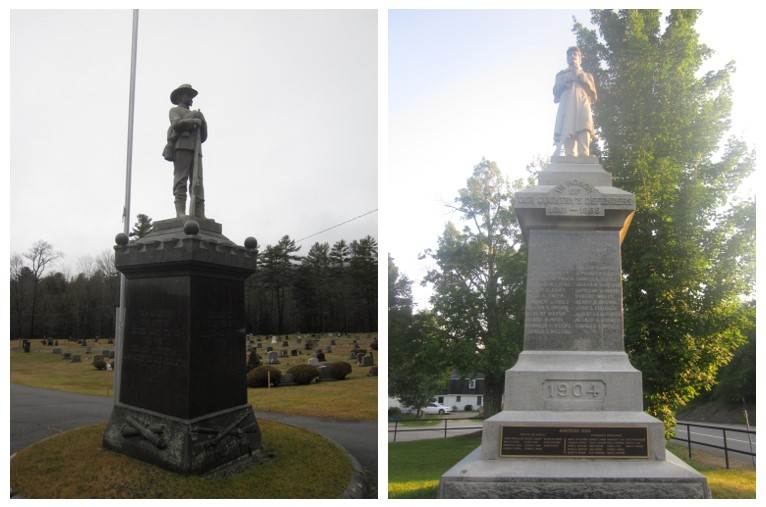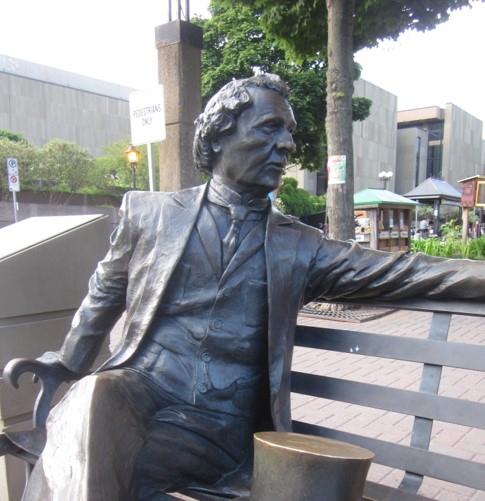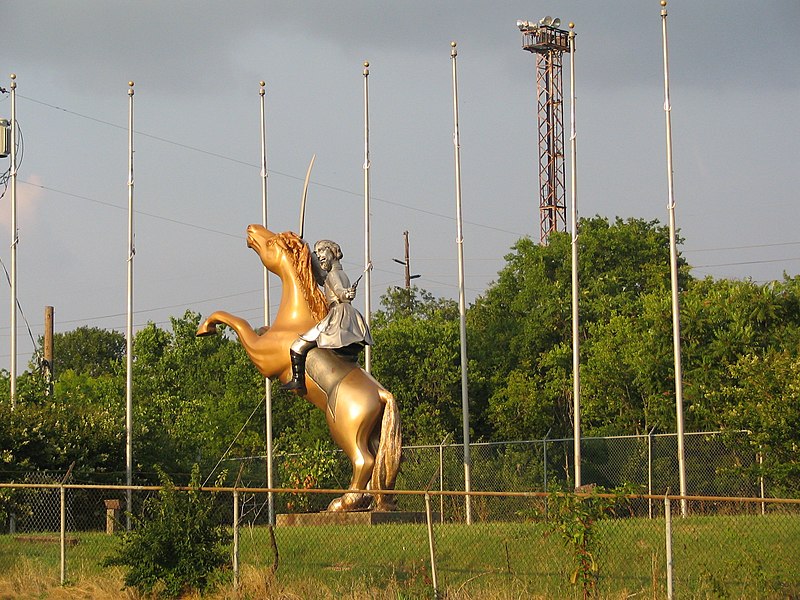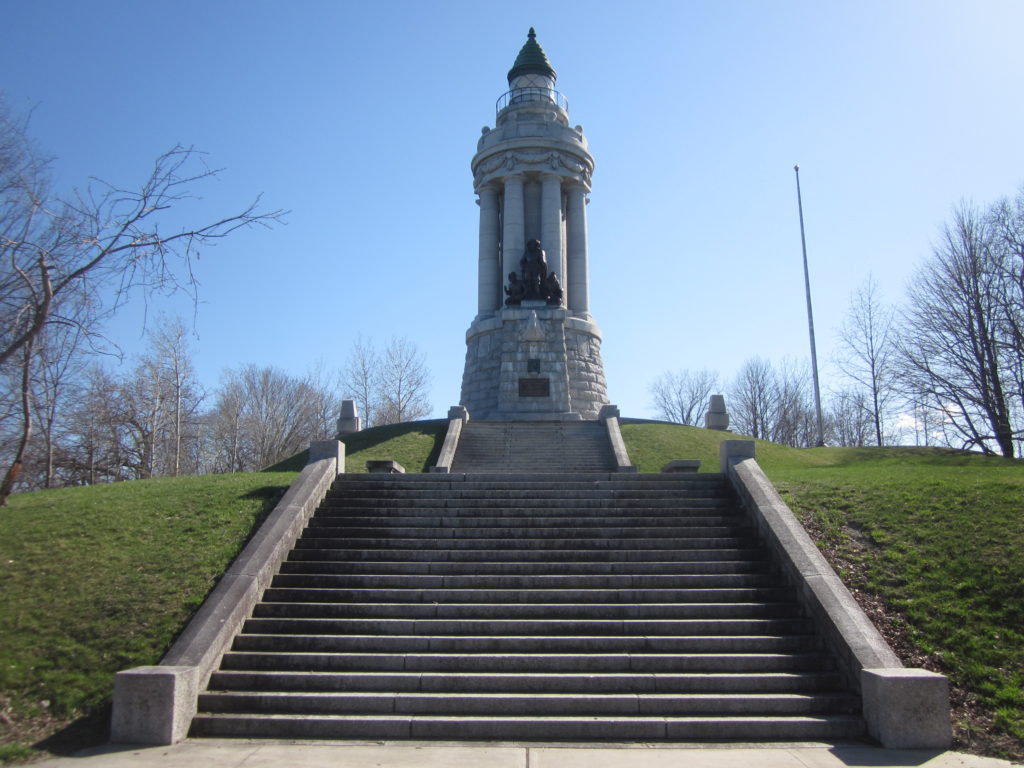In my many road trips across New England and Upstate New York—sometimes for pleasure, sometimes for on-the-ground historical research, generally for both—I somehow got into the habit of photographing Civil War monuments wherever I found them. Those monuments, so often overlooked, become ubiquitous once they are on your radar.
They are overlooked notably because there is little variety: the vast majority consist of the likeness of a Union soldier standing on a granite pedestal with a brief historical inscription. Most memorialize the soldiers who fell while performing their duty during the “War of the Rebellion.” There are few Lincolns, Grants, Shermans, and so forth; the innumerable towns that erected these monuments were interested in honoring their local dead rather than the men at the top.
As my image collection grew and grew, it turned into a powerful teaching tool in my modern American history courses. With my students I could discuss the changing meaning and commemoration of the Civil War in the South but also in the North. I learned early on that these monuments did not instantly pop up following the war, as one might naturally suspect. Granted, the one in Concord, Massachusetts, dates from 1866; Woonsocket, Rhode Island, dedicated its own monument in 1870. But many more were not built until the last decade and a half of the century. The monuments in York, Maine; Littleton, New Hampshire; Burlington, Vermont; and Ticonderoga, New York, were all built in the early twentieth century.

In the classroom, the discussion questions came easily. How do the “War of the Rebellion” and the “Civil War” differ in meaning? What exactly are these monuments depicting? Why might so many of them have been built decades after the war ended? What were people choosing to remember—or to forget? (I hasten to note here that practically none mention slavery.)
To put it differently, and plainly, the monuments served as a starting point for historical reflection, interpretation, and analysis. Instead of taking them as history-in-itself—as a true-to-life depiction of the Civil War era—we used these artifacts to shed critical light on the past. Context, some of it hidden or only hinted at in these monuments, mattered a great deal.
At this point, I am certain that readers who are historians or history buffs—perhaps a lot of general readers too—are nodding vigorously and thinking, “Well yes, of course.” That’s plain old historical analysis, isn’t it? Don’t take anything at face value; approach the past not through pre-established facts, but through documents that inform us (or seem to inform us) about those facts. By assessing these documents’ context, authenticity, credibility, intent, audience, and so forth, we are better equipped to make sense of the past.
It might not be surprising, then, in light of this, that most historians that I have spoken with have a fairly nuanced view of historical monuments.
In our media culture, that nuance doesn’t play well. In a sea of stories calculated to entertain or spark outrage, the sic et non approach fails to draw attention; that it doesn’t fit perfectly in the ideological categories that dominate our discourse also reduce it to invisibility. In the last month and a half, historians have written powerful, insightful, thought-provoking pieces on the subject. But, as with the monuments themselves, if you are not actively looking for these articles, you will likely miss them altogether.

In its current incarnation, the conversation over monuments grew out of protests following the murder of George Floyd.[1] The unrest was a necessary response to police brutality in a system that has left few if any other means to challenge racial injustice. Willfully or through ignorance, people in power have temporized or closed opportunities for meaningful institutional change. Protesters have gone further by taking on symbols of oppression and bringing down monuments that honored those who enslaved, destroyed, and marginalized. Opponents have denounced this practice as an assault on history itself (or heritage) or borrowed from the law-and-order script to condemn the destruction of public property.
Sic
In this humble historian’s view, one of these positions is far more defensible than the other. I do not belong to a historically marginalized minority group, but it doesn’t require much of a thought experiment to realize how problematic it is to put a person known and commemorated for his defense of slavery, for instance, on a literal pedestal. Statues of Confederate leaders—to say nothing of military bases named in their honor—are perhaps the most extreme or egregious case. Not all monuments are equal in this debate. But it remains that many monuments were built specifically to commemorate actions that have held back or undermined the rights of certain groups. Not having experienced what most of these groups have, it would be presumptuous and altogether disrespectful of me to weigh in on what is or isn’t a symbol of hate—a symbol of a painful history. I therefore defer to them.
Further, as I alluded to above, monuments are not history-in-itself. Christopher Columbus, Andrew Jackson, and Jefferson Davis will still draw the interest of historians, if taken down from their perches; it is inconceivable that they will ever disappear from American history textbooks. Heck, it may be that with fewer monuments, more tourists will set foot in local museums for their dose of history. In any event, as historical documents, monuments say a lot less about the events they purport to depict than about those who created them after the fact—the real “take down” is of those who sought to perpetuate the legacy of people whose actions were altogether reprehensible.

Non
But reprehensible by whose standards? I am not suggesting complete moral relativism, or even arguing that morality has no place in this conversation. But claiming the high ground is problematic is several regards. First, an incredibly small proportion of historical figures can even come close to the threshold for recognition that we are establishing. Second, we ourselves are complex, fallible human beings and many people seem to be holding historical figures to a higher standard. And, finally, we are confronted with the challenge of collectively setting that threshold. What do we do with abolitionists who were committed to traditional gender roles? What do we do with women who successfully led the female suffrage movement but who had doubts about immigrants’ fitness for citizenship? These are tough questions we need to confront.
Some readers might think, “Well, then, let’s just get rid of all of them.” But I think this is destructive in more than simply the physical sense. The polarization that I mentioned has led to growing intolerance for moral nuance and cultural difference—an aversion to meeting people halfway, understanding others on their own terms, seeking common ground, appreciating difference, and empathizing. “Cancel culture” is one manifestation of this tendency—as would be an utter and complete iconoclasm that seeks to eradicate the unpalatable in all of its forms.
In this sense, monuments to people with controversial views can serve an educational purpose (not to excuse, as some people would, but to explain) and support the great virtues of history education: appreciating complexity, understanding the roots of current issues, and becoming more compassionate. By destroying the built landscape of history, however misleading on the surface, we are taking away one means of conversing about mixed legacies.[2]
It should be clear by now that I am sensitive to both sides of the issue. It should also be clear that all monuments are not equal. We cannot honestly equate the Civil War monuments I have photographed in the Northeast to a statue of Nathan Bedford Forrest.[3] Which monuments will remain and which will go is a discussion entirely worth having. That’s my bias: respectful historical conversations are always worthwhile.

When consensus seems unachievable, we have other options and I am far more partial to these than to the positions staked by the uncompromising:
- Build a “counter monument” in the vicinity of an older, controversial one to spark historical conversation and express the experience of marginalized groups.
- Contextualize monuments with accompanying plaques or audio, or by fully recognizing painful legacies on historical tours. This is set to happen in Plattsburgh, New York.
- Remove the statue, but keep the pedestal, in a way that is reminiscent of the empty Benedict Arnold alcove at the Saratoga Battle Monument. This is a middle way that “invisibilizes” symbols of a dark history while inviting reflection.
- Move monuments to a museum where they can be acknowledged as artifacts (rather than history-in-itself or official symbols) and where the hard work of interpretation can begin.
- Ensure that municipal governments enact policies that build inclusive public spaces in which everyone can feel welcome and recognized. Such measures would range from the more symbolic—pronouncements honoring silenced stories and people—to the tangible, including funds enabling minority groups to redress a history of harmful policies.
In all cases, these measures should be undertaken through community partnerships. Good history is a chorus of voices and we need to ensure that those of minority groups (women, people of color, Indigenous groups, individuals identifying as LGBTQ+, some religious and cultural minorities, etc.) are finally included when often they have not.
The passionate exchange between both ends of the debate suggests that symbols matter—and, significantly, people care deeply about history. I hope that this societal conversation can continue to nourish our interest in the past, help us become more empathetic, and build a more inclusive and equitable society, all the while doing justice to the facts. That tall order requires an appreciation for nuance, for uncomfortable grey zones, however, and that alone tempers my optimism.
[1] Similar debates occurred in the wake of the Charleston church shooting and the Charlottesville “Unite the Right” rally. For earlier conversations that occurred largely along the same lines, consider reading Linenthal & Engelhardt’s History Wars.
[2] I am therefore reluctant to argue that this merely a debate between proper history and nostalgia, as some suggest.
[3] We can make a distinction between those figures whose impact was more beneficial than bad, on one hand, and those whose legacy lies in diminishing certain groups on the other. Thus Annette Gordon-Reed distinguishes slave owners Washington and Jefferson from those who fought for the later Confederacy.
Leave a Reply